Corporate Finance (FNCE201) - Microsoft Advanced Valuation Report
VerifiedAdded on 2022/02/28
|18
|5271
|391
Report
AI Summary
This comprehensive report provides a detailed financial analysis and valuation of Microsoft Corporation. It begins with an overview of the company, its industry, and recent acquisitions, highlighting Microsoft's strong market position and growth drivers. The report then delves into Microsoft's capital structure and estimates its equity beta using the Capital Asset Pricing Model (CAPM) and company comparable analysis. Various valuation methods, including the Dividend Discount Model (DDM), Discounted Cash Flow (DCF) model, and relative valuation, are employed to determine the company's intrinsic value. The report also addresses potential estimation errors and discusses the risks associated with Microsoft. Finally, it offers investment recommendations based on the valuation results and provides a SWOT analysis to summarize the company's strengths, weaknesses, opportunities, and threats. The report concludes with a detailed appendix including supporting figures and data.
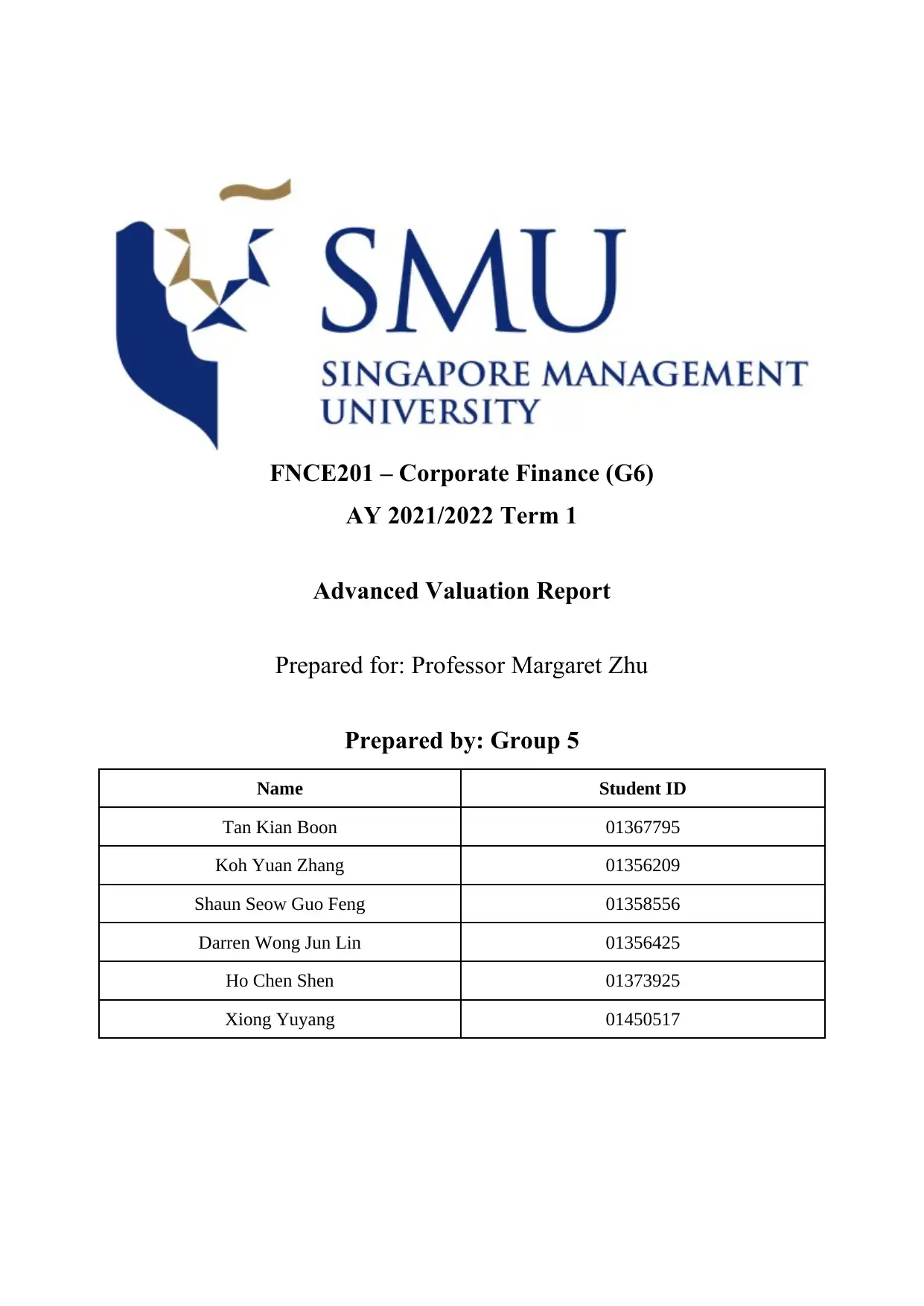
FNCE201 – Corporate Finance (G6)
AY 2021/2022 Term 1
Advanced Valuation Report
Prepared for: Professor Margaret Zhu
Prepared by: Group 5
Name Student ID
Tan Kian Boon 01367795
Koh Yuan Zhang 01356209
Shaun Seow Guo Feng 01358556
Darren Wong Jun Lin 01356425
Ho Chen Shen 01373925
Xiong Yuyang 01450517
AY 2021/2022 Term 1
Advanced Valuation Report
Prepared for: Professor Margaret Zhu
Prepared by: Group 5
Name Student ID
Tan Kian Boon 01367795
Koh Yuan Zhang 01356209
Shaun Seow Guo Feng 01358556
Darren Wong Jun Lin 01356425
Ho Chen Shen 01373925
Xiong Yuyang 01450517
Paraphrase This Document
Need a fresh take? Get an instant paraphrase of this document with our AI Paraphraser
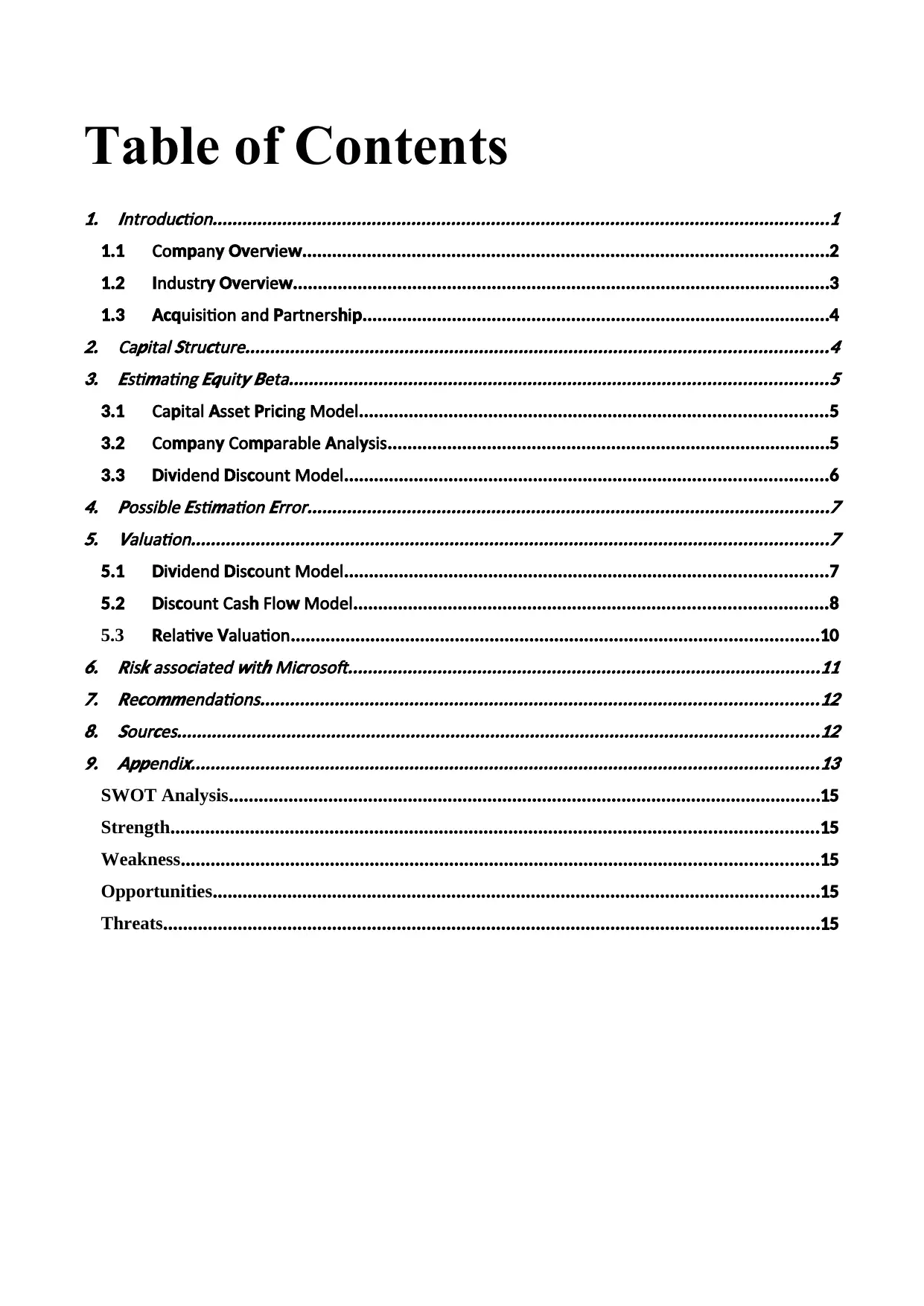
Table of Contents
1. ntrodu tion
I c ............................................................................................................................1
1.1 Co an er iemp y Ov v w..........................................................................................................2
1.2 ndustr er ieI y Ov v w............................................................................................................3
1.3 uisition and artners iAcq P h p..............................................................................................4
2. Ca ital tru ture
p S c .....................................................................................................................4
3. sti ating uit eta
E m Eq y B ............................................................................................................5
3.1 Ca ital sset ri ing Modelp A P c ..............................................................................................5
3.2 Co an Co arable nal sismp y mp A y .........................................................................................5
3.3 i idend is ount ModelD v D c .................................................................................................6
4. ossible sti ation rror
P E m E .........................................................................................................7
5. aluation
V ................................................................................................................................7
5.1 i idend is ount ModelD v D c .................................................................................................7
5.2 is ount Cas Flo ModelD c h w ...............................................................................................8
5.3 elati e aluationR v V ..........................................................................................................10
6. is asso iated it Mi rosoft
R k c w h c ...............................................................................................11
7. e o endations
R c mm
................................................................................................................12
8. our es
S c .................................................................................................................................12
9. endi
App x..............................................................................................................................13
SWOT Analysis.......................................................................................................................15
Strength..................................................................................................................................15
Weakness................................................................................................................................15
Opportunities..........................................................................................................................15
Threats....................................................................................................................................15
1. ntrodu tion
I c ............................................................................................................................1
1.1 Co an er iemp y Ov v w..........................................................................................................2
1.2 ndustr er ieI y Ov v w............................................................................................................3
1.3 uisition and artners iAcq P h p..............................................................................................4
2. Ca ital tru ture
p S c .....................................................................................................................4
3. sti ating uit eta
E m Eq y B ............................................................................................................5
3.1 Ca ital sset ri ing Modelp A P c ..............................................................................................5
3.2 Co an Co arable nal sismp y mp A y .........................................................................................5
3.3 i idend is ount ModelD v D c .................................................................................................6
4. ossible sti ation rror
P E m E .........................................................................................................7
5. aluation
V ................................................................................................................................7
5.1 i idend is ount ModelD v D c .................................................................................................7
5.2 is ount Cas Flo ModelD c h w ...............................................................................................8
5.3 elati e aluationR v V ..........................................................................................................10
6. is asso iated it Mi rosoft
R k c w h c ...............................................................................................11
7. e o endations
R c mm
................................................................................................................12
8. our es
S c .................................................................................................................................12
9. endi
App x..............................................................................................................................13
SWOT Analysis.......................................................................................................................15
Strength..................................................................................................................................15
Weakness................................................................................................................................15
Opportunities..........................................................................................................................15
Threats....................................................................................................................................15
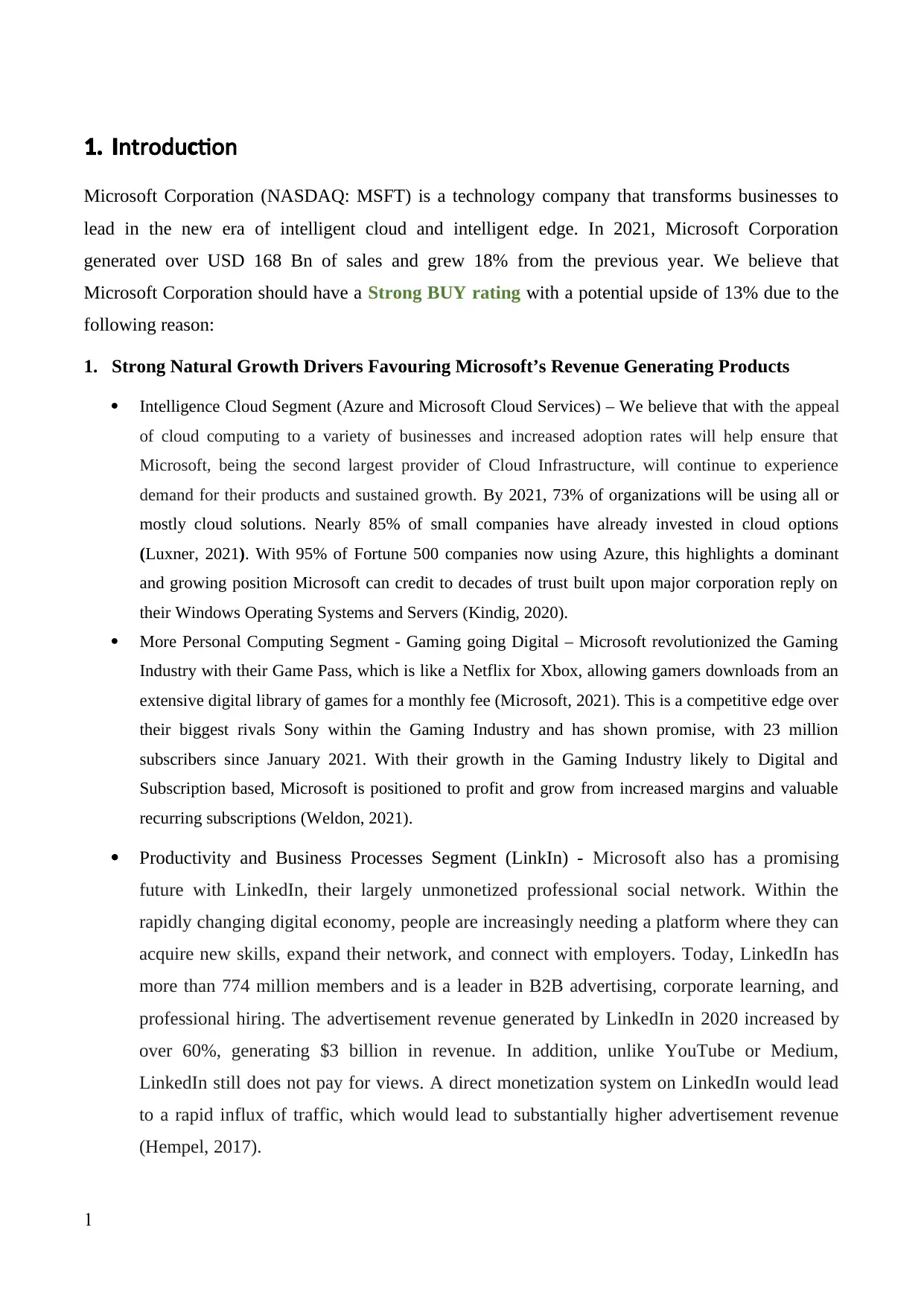
1. ntrodu tionI c
Microsoft Corporation (NASDAQ: MSFT) is a technology company that transforms businesses to
lead in the new era of intelligent cloud and intelligent edge. In 2021, Microsoft Corporation
generated over USD 168 Bn of sales and grew 18% from the previous year. We believe that
Microsoft Corporation should have a Strong BUY rating with a potential upside of 13% due to the
following reason:
1. Strong Natural Growth Drivers Favouring Microsoft’s Revenue Generating Products
Intelligence Cloud Segment (Azure and Microsoft Cloud Services) – We believe that with the appeal
of cloud computing to a variety of businesses and increased adoption rates will help ensure that
Microsoft, being the second largest provider of Cloud Infrastructure, will continue to experience
demand for their products and sustained growth. By 2021, 73% of organizations will be using all or
mostly cloud solutions. Nearly 85% of small companies have already invested in cloud options
(Luxner, 2021). With 95% of Fortune 500 companies now using Azure, this highlights a dominant
and growing position Microsoft can credit to decades of trust built upon major corporation reply on
their Windows Operating Systems and Servers (Kindig, 2020).
More Personal Computing Segment - Gaming going Digital – Microsoft revolutionized the Gaming
Industry with their Game Pass, which is like a Netflix for Xbox, allowing gamers downloads from an
extensive digital library of games for a monthly fee (Microsoft, 2021). This is a competitive edge over
their biggest rivals Sony within the Gaming Industry and has shown promise, with 23 million
subscribers since January 2021. With their growth in the Gaming Industry likely to Digital and
Subscription based, Microsoft is positioned to profit and grow from increased margins and valuable
recurring subscriptions (Weldon, 2021).
Productivity and Business Processes Segment (LinkIn) - Microsoft also has a promising
future with LinkedIn, their largely unmonetized professional social network. Within the
rapidly changing digital economy, people are increasingly needing a platform where they can
acquire new skills, expand their network, and connect with employers. Today, LinkedIn has
more than 774 million members and is a leader in B2B advertising, corporate learning, and
professional hiring. The advertisement revenue generated by LinkedIn in 2020 increased by
over 60%, generating $3 billion in revenue. In addition, unlike YouTube or Medium,
LinkedIn still does not pay for views. A direct monetization system on LinkedIn would lead
to a rapid influx of traffic, which would lead to substantially higher advertisement revenue
(Hempel, 2017).
1
Microsoft Corporation (NASDAQ: MSFT) is a technology company that transforms businesses to
lead in the new era of intelligent cloud and intelligent edge. In 2021, Microsoft Corporation
generated over USD 168 Bn of sales and grew 18% from the previous year. We believe that
Microsoft Corporation should have a Strong BUY rating with a potential upside of 13% due to the
following reason:
1. Strong Natural Growth Drivers Favouring Microsoft’s Revenue Generating Products
Intelligence Cloud Segment (Azure and Microsoft Cloud Services) – We believe that with the appeal
of cloud computing to a variety of businesses and increased adoption rates will help ensure that
Microsoft, being the second largest provider of Cloud Infrastructure, will continue to experience
demand for their products and sustained growth. By 2021, 73% of organizations will be using all or
mostly cloud solutions. Nearly 85% of small companies have already invested in cloud options
(Luxner, 2021). With 95% of Fortune 500 companies now using Azure, this highlights a dominant
and growing position Microsoft can credit to decades of trust built upon major corporation reply on
their Windows Operating Systems and Servers (Kindig, 2020).
More Personal Computing Segment - Gaming going Digital – Microsoft revolutionized the Gaming
Industry with their Game Pass, which is like a Netflix for Xbox, allowing gamers downloads from an
extensive digital library of games for a monthly fee (Microsoft, 2021). This is a competitive edge over
their biggest rivals Sony within the Gaming Industry and has shown promise, with 23 million
subscribers since January 2021. With their growth in the Gaming Industry likely to Digital and
Subscription based, Microsoft is positioned to profit and grow from increased margins and valuable
recurring subscriptions (Weldon, 2021).
Productivity and Business Processes Segment (LinkIn) - Microsoft also has a promising
future with LinkedIn, their largely unmonetized professional social network. Within the
rapidly changing digital economy, people are increasingly needing a platform where they can
acquire new skills, expand their network, and connect with employers. Today, LinkedIn has
more than 774 million members and is a leader in B2B advertising, corporate learning, and
professional hiring. The advertisement revenue generated by LinkedIn in 2020 increased by
over 60%, generating $3 billion in revenue. In addition, unlike YouTube or Medium,
LinkedIn still does not pay for views. A direct monetization system on LinkedIn would lead
to a rapid influx of traffic, which would lead to substantially higher advertisement revenue
(Hempel, 2017).
1
⊘ This is a preview!⊘
Do you want full access?
Subscribe today to unlock all pages.

Trusted by 1+ million students worldwide
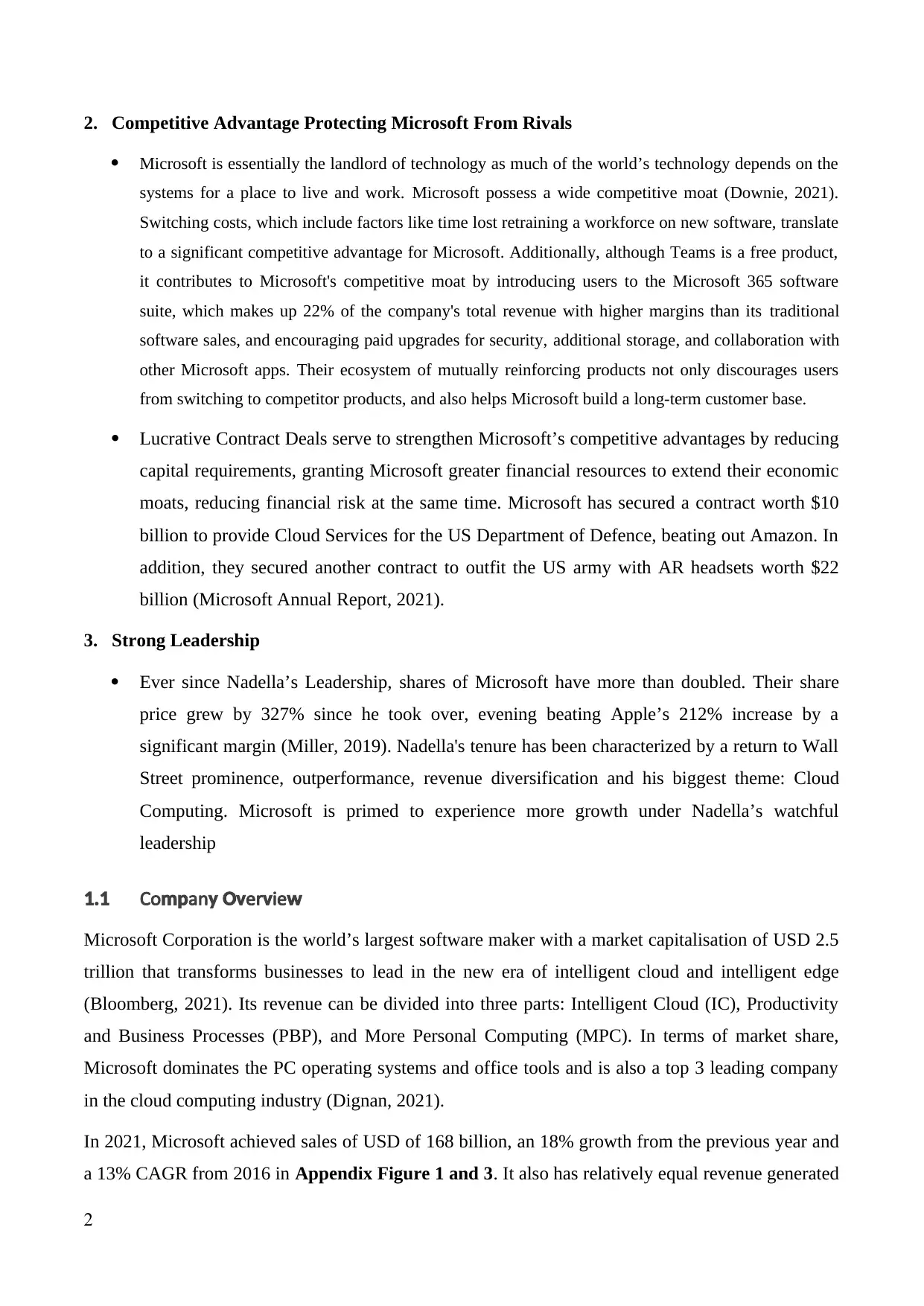
2. Competitive Advantage Protecting Microsoft From Rivals
Microsoft is essentially the landlord of technology as much of the world’s technology depends on the
systems for a place to live and work. Microsoft possess a wide competitive moat (Downie, 2021).
Switching costs, which include factors like time lost retraining a workforce on new software, translate
to a significant competitive advantage for Microsoft. Additionally, although Teams is a free product,
it contributes to Microsoft's competitive moat by introducing users to the Microsoft 365 software
suite, which makes up 22% of the company's total revenue with higher margins than its traditional
software sales, and encouraging paid upgrades for security, additional storage, and collaboration with
other Microsoft apps. Their ecosystem of mutually reinforcing products not only discourages users
from switching to competitor products, and also helps Microsoft build a long-term customer base.
Lucrative Contract Deals serve to strengthen Microsoft’s competitive advantages by reducing
capital requirements, granting Microsoft greater financial resources to extend their economic
moats, reducing financial risk at the same time. Microsoft has secured a contract worth $10
billion to provide Cloud Services for the US Department of Defence, beating out Amazon. In
addition, they secured another contract to outfit the US army with AR headsets worth $22
billion (Microsoft Annual Report, 2021).
3. Strong Leadership
Ever since Nadella’s Leadership, shares of Microsoft have more than doubled. Their share
price grew by 327% since he took over, evening beating Apple’s 212% increase by a
significant margin (Miller, 2019). Nadella's tenure has been characterized by a return to Wall
Street prominence, outperformance, revenue diversification and his biggest theme: Cloud
Computing. Microsoft is primed to experience more growth under Nadella’s watchful
leadership
1.1 Co an er iemp y Ov v w
Microsoft Corporation is the world’s largest software maker with a market capitalisation of USD 2.5
trillion that transforms businesses to lead in the new era of intelligent cloud and intelligent edge
(Bloomberg, 2021). Its revenue can be divided into three parts: Intelligent Cloud (IC), Productivity
and Business Processes (PBP), and More Personal Computing (MPC). In terms of market share,
Microsoft dominates the PC operating systems and office tools and is also a top 3 leading company
in the cloud computing industry (Dignan, 2021).
In 2021, Microsoft achieved sales of USD of 168 billion, an 18% growth from the previous year and
a 13% CAGR from 2016 in Appendix Figure 1 and 3. It also has relatively equal revenue generated
2
Microsoft is essentially the landlord of technology as much of the world’s technology depends on the
systems for a place to live and work. Microsoft possess a wide competitive moat (Downie, 2021).
Switching costs, which include factors like time lost retraining a workforce on new software, translate
to a significant competitive advantage for Microsoft. Additionally, although Teams is a free product,
it contributes to Microsoft's competitive moat by introducing users to the Microsoft 365 software
suite, which makes up 22% of the company's total revenue with higher margins than its traditional
software sales, and encouraging paid upgrades for security, additional storage, and collaboration with
other Microsoft apps. Their ecosystem of mutually reinforcing products not only discourages users
from switching to competitor products, and also helps Microsoft build a long-term customer base.
Lucrative Contract Deals serve to strengthen Microsoft’s competitive advantages by reducing
capital requirements, granting Microsoft greater financial resources to extend their economic
moats, reducing financial risk at the same time. Microsoft has secured a contract worth $10
billion to provide Cloud Services for the US Department of Defence, beating out Amazon. In
addition, they secured another contract to outfit the US army with AR headsets worth $22
billion (Microsoft Annual Report, 2021).
3. Strong Leadership
Ever since Nadella’s Leadership, shares of Microsoft have more than doubled. Their share
price grew by 327% since he took over, evening beating Apple’s 212% increase by a
significant margin (Miller, 2019). Nadella's tenure has been characterized by a return to Wall
Street prominence, outperformance, revenue diversification and his biggest theme: Cloud
Computing. Microsoft is primed to experience more growth under Nadella’s watchful
leadership
1.1 Co an er iemp y Ov v w
Microsoft Corporation is the world’s largest software maker with a market capitalisation of USD 2.5
trillion that transforms businesses to lead in the new era of intelligent cloud and intelligent edge
(Bloomberg, 2021). Its revenue can be divided into three parts: Intelligent Cloud (IC), Productivity
and Business Processes (PBP), and More Personal Computing (MPC). In terms of market share,
Microsoft dominates the PC operating systems and office tools and is also a top 3 leading company
in the cloud computing industry (Dignan, 2021).
In 2021, Microsoft achieved sales of USD of 168 billion, an 18% growth from the previous year and
a 13% CAGR from 2016 in Appendix Figure 1 and 3. It also has relatively equal revenue generated
2
Paraphrase This Document
Need a fresh take? Get an instant paraphrase of this document with our AI Paraphraser
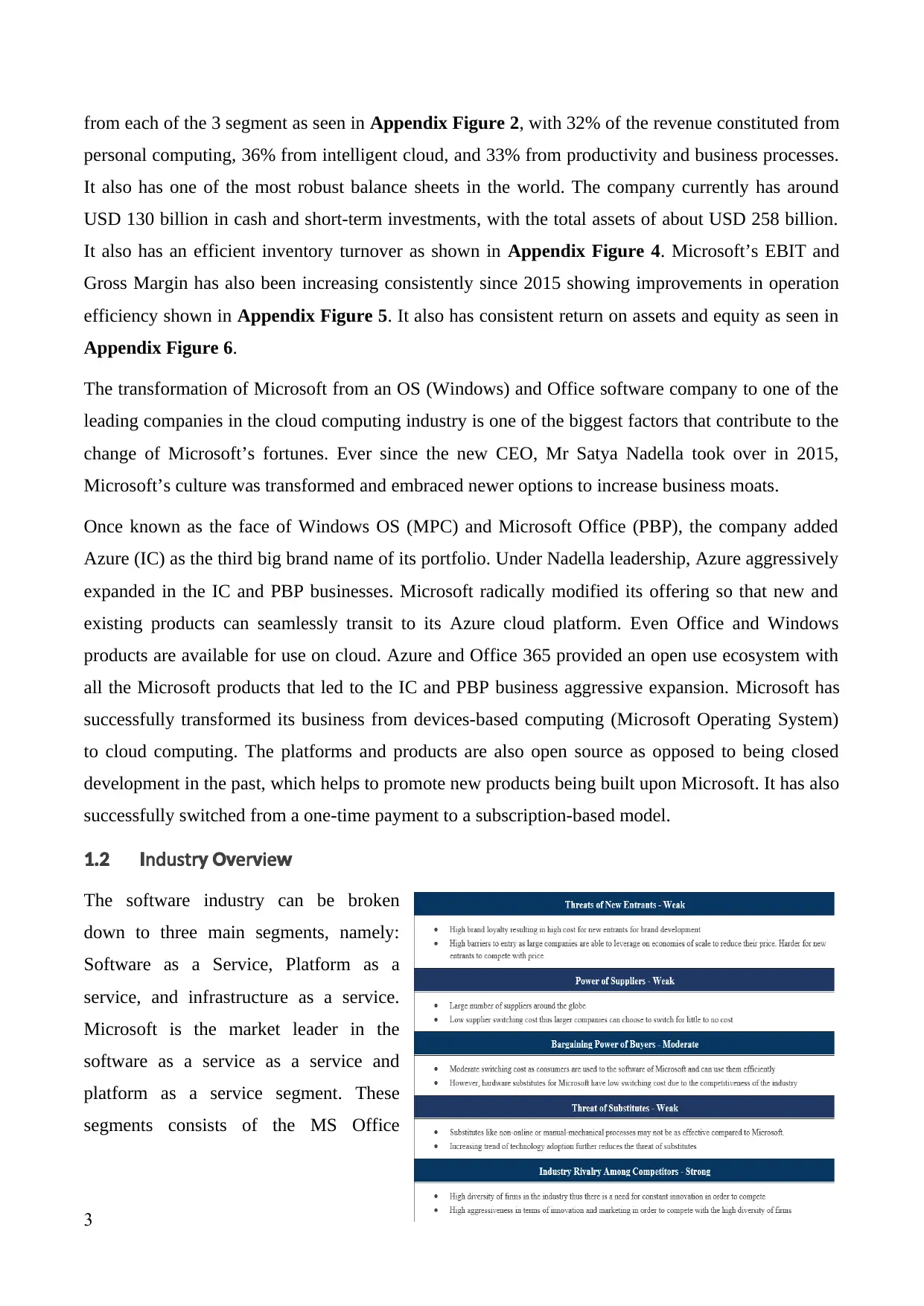
from each of the 3 segment as seen in Appendix Figure 2, with 32% of the revenue constituted from
personal computing, 36% from intelligent cloud, and 33% from productivity and business processes.
It also has one of the most robust balance sheets in the world. The company currently has around
USD 130 billion in cash and short-term investments, with the total assets of about USD 258 billion.
It also has an efficient inventory turnover as shown in Appendix Figure 4. Microsoft’s EBIT and
Gross Margin has also been increasing consistently since 2015 showing improvements in operation
efficiency shown in Appendix Figure 5. It also has consistent return on assets and equity as seen in
Appendix Figure 6.
The transformation of Microsoft from an OS (Windows) and Office software company to one of the
leading companies in the cloud computing industry is one of the biggest factors that contribute to the
change of Microsoft’s fortunes. Ever since the new CEO, Mr Satya Nadella took over in 2015,
Microsoft’s culture was transformed and embraced newer options to increase business moats.
Once known as the face of Windows OS (MPC) and Microsoft Office (PBP), the company added
Azure (IC) as the third big brand name of its portfolio. Under Nadella leadership, Azure aggressively
expanded in the IC and PBP businesses. Microsoft radically modified its offering so that new and
existing products can seamlessly transit to its Azure cloud platform. Even Office and Windows
products are available for use on cloud. Azure and Office 365 provided an open use ecosystem with
all the Microsoft products that led to the IC and PBP business aggressive expansion. Microsoft has
successfully transformed its business from devices-based computing (Microsoft Operating System)
to cloud computing. The platforms and products are also open source as opposed to being closed
development in the past, which helps to promote new products being built upon Microsoft. It has also
successfully switched from a one-time payment to a subscription-based model.
1.2 ndustr er ieI y Ov v w
The software industry can be broken
down to three main segments, namely:
Software as a Service, Platform as a
service, and infrastructure as a service.
Microsoft is the market leader in the
software as a service as a service and
platform as a service segment. These
segments consists of the MS Office
3
personal computing, 36% from intelligent cloud, and 33% from productivity and business processes.
It also has one of the most robust balance sheets in the world. The company currently has around
USD 130 billion in cash and short-term investments, with the total assets of about USD 258 billion.
It also has an efficient inventory turnover as shown in Appendix Figure 4. Microsoft’s EBIT and
Gross Margin has also been increasing consistently since 2015 showing improvements in operation
efficiency shown in Appendix Figure 5. It also has consistent return on assets and equity as seen in
Appendix Figure 6.
The transformation of Microsoft from an OS (Windows) and Office software company to one of the
leading companies in the cloud computing industry is one of the biggest factors that contribute to the
change of Microsoft’s fortunes. Ever since the new CEO, Mr Satya Nadella took over in 2015,
Microsoft’s culture was transformed and embraced newer options to increase business moats.
Once known as the face of Windows OS (MPC) and Microsoft Office (PBP), the company added
Azure (IC) as the third big brand name of its portfolio. Under Nadella leadership, Azure aggressively
expanded in the IC and PBP businesses. Microsoft radically modified its offering so that new and
existing products can seamlessly transit to its Azure cloud platform. Even Office and Windows
products are available for use on cloud. Azure and Office 365 provided an open use ecosystem with
all the Microsoft products that led to the IC and PBP business aggressive expansion. Microsoft has
successfully transformed its business from devices-based computing (Microsoft Operating System)
to cloud computing. The platforms and products are also open source as opposed to being closed
development in the past, which helps to promote new products being built upon Microsoft. It has also
successfully switched from a one-time payment to a subscription-based model.
1.2 ndustr er ieI y Ov v w
The software industry can be broken
down to three main segments, namely:
Software as a Service, Platform as a
service, and infrastructure as a service.
Microsoft is the market leader in the
software as a service as a service and
platform as a service segment. These
segments consists of the MS Office
3
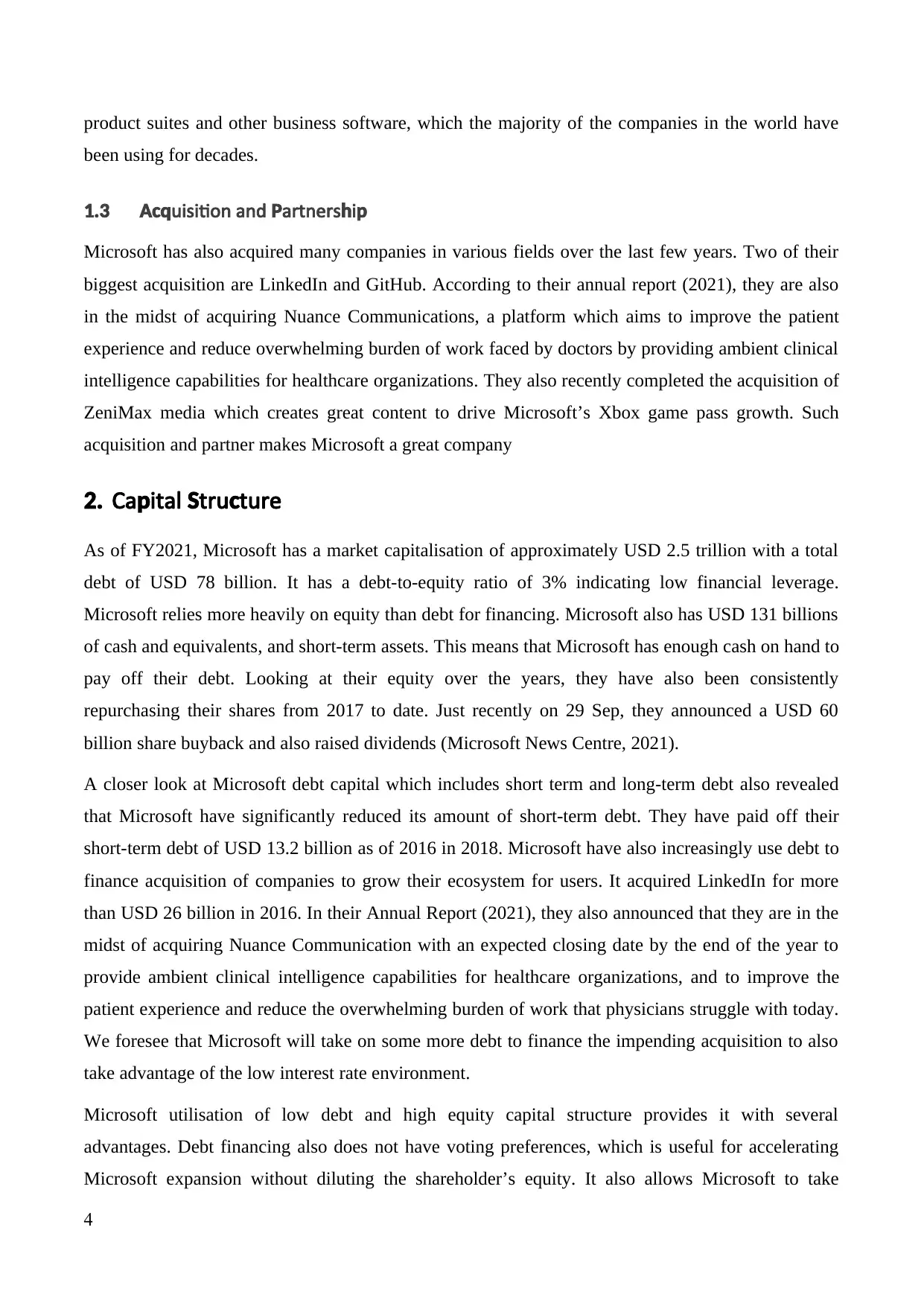
product suites and other business software, which the majority of the companies in the world have
been using for decades.
1.3 uisition and artners iAcq P h p
Microsoft has also acquired many companies in various fields over the last few years. Two of their
biggest acquisition are LinkedIn and GitHub. According to their annual report (2021), they are also
in the midst of acquiring Nuance Communications, a platform which aims to improve the patient
experience and reduce overwhelming burden of work faced by doctors by providing ambient clinical
intelligence capabilities for healthcare organizations. They also recently completed the acquisition of
ZeniMax media which creates great content to drive Microsoft’s Xbox game pass growth. Such
acquisition and partner makes Microsoft a great company
2. Ca ital tru turep S c
As of FY2021, Microsoft has a market capitalisation of approximately USD 2.5 trillion with a total
debt of USD 78 billion. It has a debt-to-equity ratio of 3% indicating low financial leverage.
Microsoft relies more heavily on equity than debt for financing. Microsoft also has USD 131 billions
of cash and equivalents, and short-term assets. This means that Microsoft has enough cash on hand to
pay off their debt. Looking at their equity over the years, they have also been consistently
repurchasing their shares from 2017 to date. Just recently on 29 Sep, they announced a USD 60
billion share buyback and also raised dividends (Microsoft News Centre, 2021).
A closer look at Microsoft debt capital which includes short term and long-term debt also revealed
that Microsoft have significantly reduced its amount of short-term debt. They have paid off their
short-term debt of USD 13.2 billion as of 2016 in 2018. Microsoft have also increasingly use debt to
finance acquisition of companies to grow their ecosystem for users. It acquired LinkedIn for more
than USD 26 billion in 2016. In their Annual Report (2021), they also announced that they are in the
midst of acquiring Nuance Communication with an expected closing date by the end of the year to
provide ambient clinical intelligence capabilities for healthcare organizations, and to improve the
patient experience and reduce the overwhelming burden of work that physicians struggle with today.
We foresee that Microsoft will take on some more debt to finance the impending acquisition to also
take advantage of the low interest rate environment.
Microsoft utilisation of low debt and high equity capital structure provides it with several
advantages. Debt financing also does not have voting preferences, which is useful for accelerating
Microsoft expansion without diluting the shareholder’s equity. It also allows Microsoft to take
4
been using for decades.
1.3 uisition and artners iAcq P h p
Microsoft has also acquired many companies in various fields over the last few years. Two of their
biggest acquisition are LinkedIn and GitHub. According to their annual report (2021), they are also
in the midst of acquiring Nuance Communications, a platform which aims to improve the patient
experience and reduce overwhelming burden of work faced by doctors by providing ambient clinical
intelligence capabilities for healthcare organizations. They also recently completed the acquisition of
ZeniMax media which creates great content to drive Microsoft’s Xbox game pass growth. Such
acquisition and partner makes Microsoft a great company
2. Ca ital tru turep S c
As of FY2021, Microsoft has a market capitalisation of approximately USD 2.5 trillion with a total
debt of USD 78 billion. It has a debt-to-equity ratio of 3% indicating low financial leverage.
Microsoft relies more heavily on equity than debt for financing. Microsoft also has USD 131 billions
of cash and equivalents, and short-term assets. This means that Microsoft has enough cash on hand to
pay off their debt. Looking at their equity over the years, they have also been consistently
repurchasing their shares from 2017 to date. Just recently on 29 Sep, they announced a USD 60
billion share buyback and also raised dividends (Microsoft News Centre, 2021).
A closer look at Microsoft debt capital which includes short term and long-term debt also revealed
that Microsoft have significantly reduced its amount of short-term debt. They have paid off their
short-term debt of USD 13.2 billion as of 2016 in 2018. Microsoft have also increasingly use debt to
finance acquisition of companies to grow their ecosystem for users. It acquired LinkedIn for more
than USD 26 billion in 2016. In their Annual Report (2021), they also announced that they are in the
midst of acquiring Nuance Communication with an expected closing date by the end of the year to
provide ambient clinical intelligence capabilities for healthcare organizations, and to improve the
patient experience and reduce the overwhelming burden of work that physicians struggle with today.
We foresee that Microsoft will take on some more debt to finance the impending acquisition to also
take advantage of the low interest rate environment.
Microsoft utilisation of low debt and high equity capital structure provides it with several
advantages. Debt financing also does not have voting preferences, which is useful for accelerating
Microsoft expansion without diluting the shareholder’s equity. It also allows Microsoft to take
4
⊘ This is a preview!⊘
Do you want full access?
Subscribe today to unlock all pages.

Trusted by 1+ million students worldwide
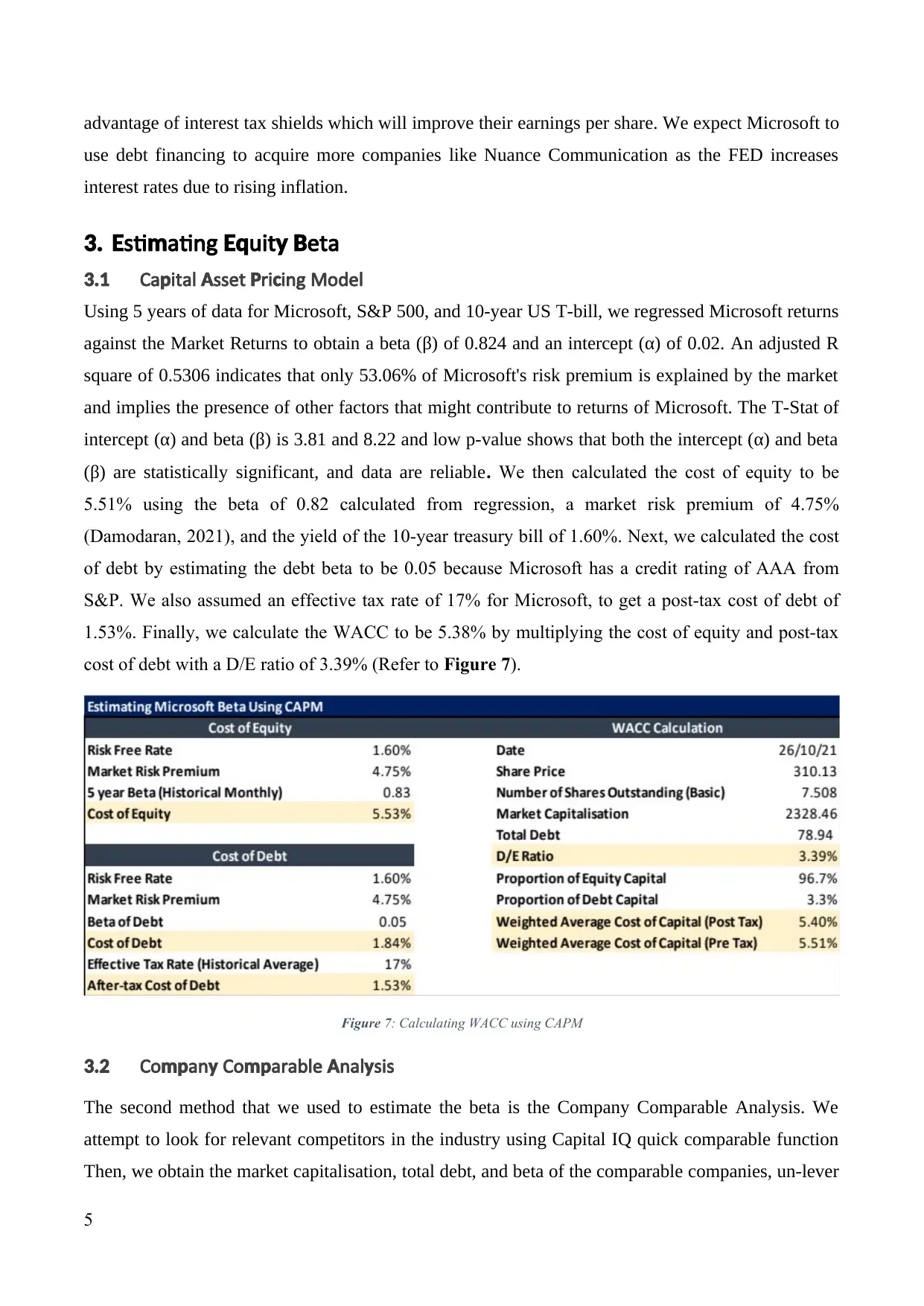
advantage of interest tax shields which will improve their earnings per share. We expect Microsoft to
use debt financing to acquire more companies like Nuance Communication as the FED increases
interest rates due to rising inflation.
3. sti ating uit etaE m Eq y B
3.1 Ca ital sset ri ing Modelp A P c
Using 5 years of data for Microsoft, S&P 500, and 10-year US T-bill, we regressed Microsoft returns
against the Market Returns to obtain a beta (β) of 0.824 and an intercept (α) of 0.02. An adjusted R
square of 0.5306 indicates that only 53.06% of Microsoft's risk premium is explained by the market
and implies the presence of other factors that might contribute to returns of Microsoft. The T-Stat of
intercept (α) and beta (β) is 3.81 and 8.22 and low p-value shows that both the intercept (α) and beta
(β) are statistically significant, and data are reliable. We then calculated the cost of equity to be
5.51% using the beta of 0.82 calculated from regression, a market risk premium of 4.75%
(Damodaran, 2021), and the yield of the 10-year treasury bill of 1.60%. Next, we calculated the cost
of debt by estimating the debt beta to be 0.05 because Microsoft has a credit rating of AAA from
S&P. We also assumed an effective tax rate of 17% for Microsoft, to get a post-tax cost of debt of
1.53%. Finally, we calculate the WACC to be 5.38% by multiplying the cost of equity and post-tax
cost of debt with a D/E ratio of 3.39% (Refer to Figure 7).
Figure 7: Calculating WACC using CAPM
3.2 Co an Co arable nal sismp y mp A y
The second method that we used to estimate the beta is the Company Comparable Analysis. We
attempt to look for relevant competitors in the industry using Capital IQ quick comparable function
Then, we obtain the market capitalisation, total debt, and beta of the comparable companies, un-lever
5
use debt financing to acquire more companies like Nuance Communication as the FED increases
interest rates due to rising inflation.
3. sti ating uit etaE m Eq y B
3.1 Ca ital sset ri ing Modelp A P c
Using 5 years of data for Microsoft, S&P 500, and 10-year US T-bill, we regressed Microsoft returns
against the Market Returns to obtain a beta (β) of 0.824 and an intercept (α) of 0.02. An adjusted R
square of 0.5306 indicates that only 53.06% of Microsoft's risk premium is explained by the market
and implies the presence of other factors that might contribute to returns of Microsoft. The T-Stat of
intercept (α) and beta (β) is 3.81 and 8.22 and low p-value shows that both the intercept (α) and beta
(β) are statistically significant, and data are reliable. We then calculated the cost of equity to be
5.51% using the beta of 0.82 calculated from regression, a market risk premium of 4.75%
(Damodaran, 2021), and the yield of the 10-year treasury bill of 1.60%. Next, we calculated the cost
of debt by estimating the debt beta to be 0.05 because Microsoft has a credit rating of AAA from
S&P. We also assumed an effective tax rate of 17% for Microsoft, to get a post-tax cost of debt of
1.53%. Finally, we calculate the WACC to be 5.38% by multiplying the cost of equity and post-tax
cost of debt with a D/E ratio of 3.39% (Refer to Figure 7).
Figure 7: Calculating WACC using CAPM
3.2 Co an Co arable nal sismp y mp A y
The second method that we used to estimate the beta is the Company Comparable Analysis. We
attempt to look for relevant competitors in the industry using Capital IQ quick comparable function
Then, we obtain the market capitalisation, total debt, and beta of the comparable companies, un-lever
5
Paraphrase This Document
Need a fresh take? Get an instant paraphrase of this document with our AI Paraphraser
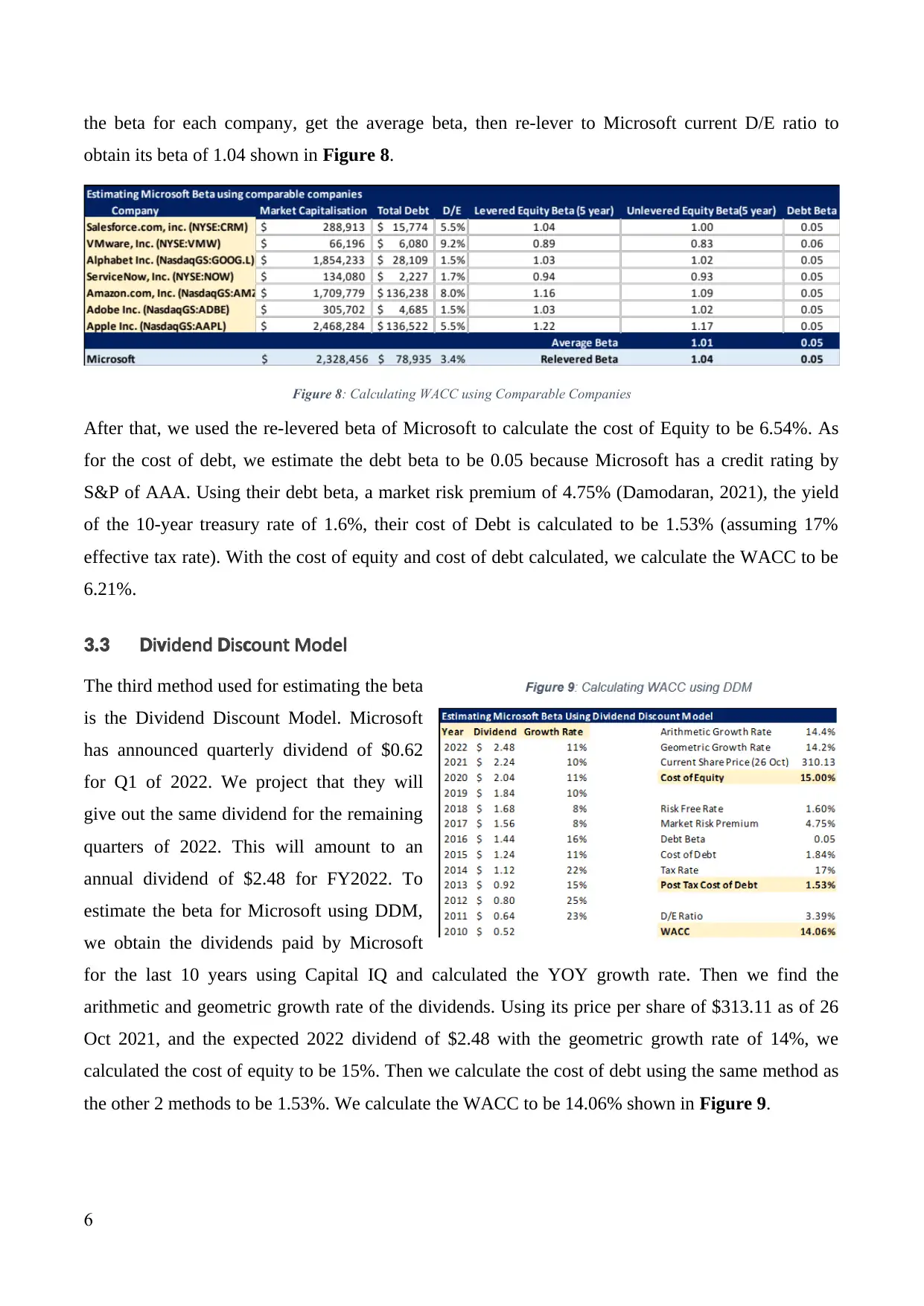
the beta for each company, get the average beta, then re-lever to Microsoft current D/E ratio to
obtain its beta of 1.04 shown in Figure 8.
Figure 8: Calculating WACC using Comparable Companies
After that, we used the re-levered beta of Microsoft to calculate the cost of Equity to be 6.54%. As
for the cost of debt, we estimate the debt beta to be 0.05 because Microsoft has a credit rating by
S&P of AAA. Using their debt beta, a market risk premium of 4.75% (Damodaran, 2021), the yield
of the 10-year treasury rate of 1.6%, their cost of Debt is calculated to be 1.53% (assuming 17%
effective tax rate). With the cost of equity and cost of debt calculated, we calculate the WACC to be
6.21%.
3.3 i idend is ount ModelD v D c
The third method used for estimating the beta
is the Dividend Discount Model. Microsoft
has announced quarterly dividend of $0.62
for Q1 of 2022. We project that they will
give out the same dividend for the remaining
quarters of 2022. This will amount to an
annual dividend of $2.48 for FY2022. To
estimate the beta for Microsoft using DDM,
we obtain the dividends paid by Microsoft
for the last 10 years using Capital IQ and calculated the YOY growth rate. Then we find the
arithmetic and geometric growth rate of the dividends. Using its price per share of $313.11 as of 26
Oct 2021, and the expected 2022 dividend of $2.48 with the geometric growth rate of 14%, we
calculated the cost of equity to be 15%. Then we calculate the cost of debt using the same method as
the other 2 methods to be 1.53%. We calculate the WACC to be 14.06% shown in Figure 9.
6
obtain its beta of 1.04 shown in Figure 8.
Figure 8: Calculating WACC using Comparable Companies
After that, we used the re-levered beta of Microsoft to calculate the cost of Equity to be 6.54%. As
for the cost of debt, we estimate the debt beta to be 0.05 because Microsoft has a credit rating by
S&P of AAA. Using their debt beta, a market risk premium of 4.75% (Damodaran, 2021), the yield
of the 10-year treasury rate of 1.6%, their cost of Debt is calculated to be 1.53% (assuming 17%
effective tax rate). With the cost of equity and cost of debt calculated, we calculate the WACC to be
6.21%.
3.3 i idend is ount ModelD v D c
The third method used for estimating the beta
is the Dividend Discount Model. Microsoft
has announced quarterly dividend of $0.62
for Q1 of 2022. We project that they will
give out the same dividend for the remaining
quarters of 2022. This will amount to an
annual dividend of $2.48 for FY2022. To
estimate the beta for Microsoft using DDM,
we obtain the dividends paid by Microsoft
for the last 10 years using Capital IQ and calculated the YOY growth rate. Then we find the
arithmetic and geometric growth rate of the dividends. Using its price per share of $313.11 as of 26
Oct 2021, and the expected 2022 dividend of $2.48 with the geometric growth rate of 14%, we
calculated the cost of equity to be 15%. Then we calculate the cost of debt using the same method as
the other 2 methods to be 1.53%. We calculate the WACC to be 14.06% shown in Figure 9.
6
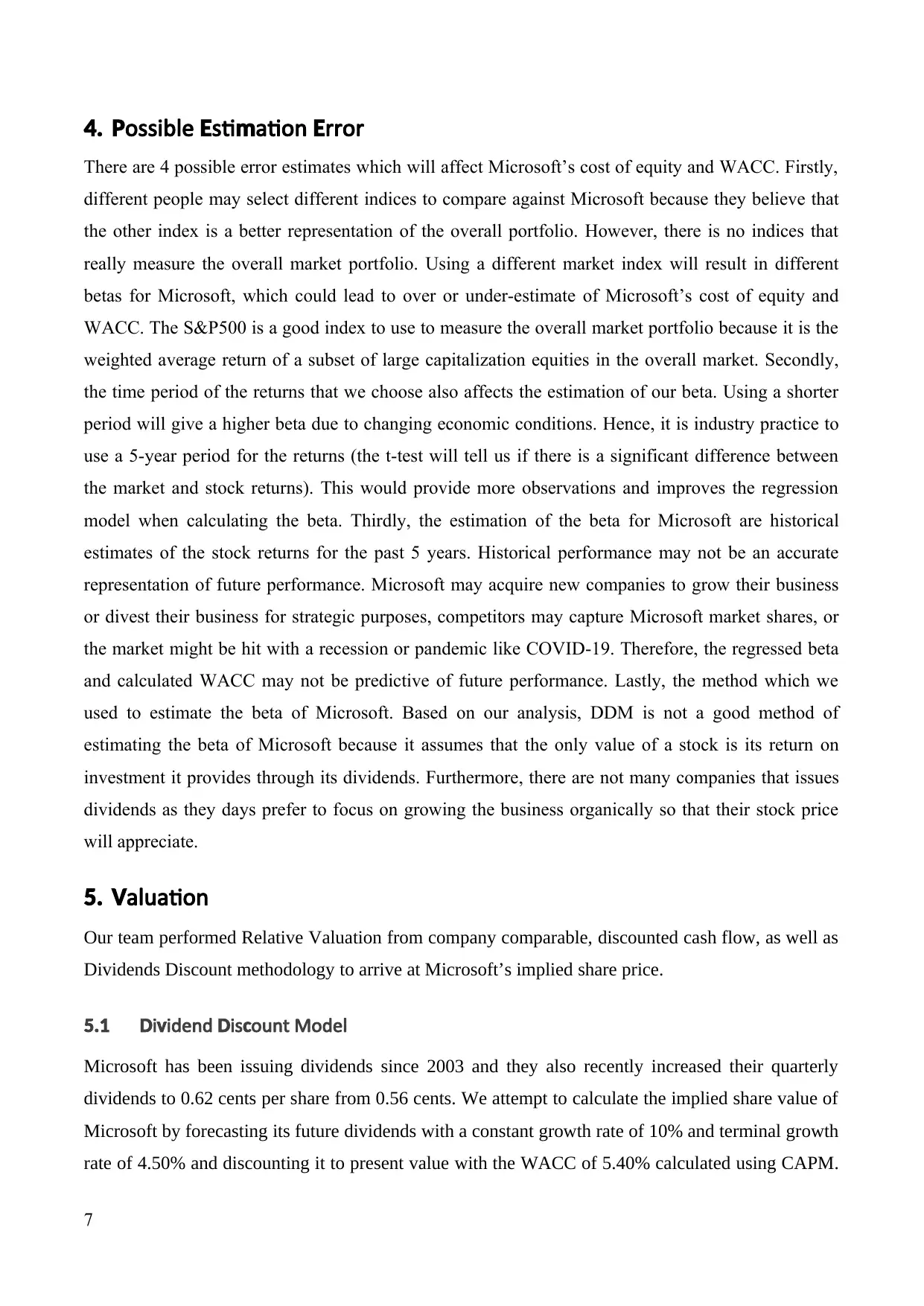
4. ossible sti ation rrorP E m E
There are 4 possible error estimates which will affect Microsoft’s cost of equity and WACC. Firstly,
different people may select different indices to compare against Microsoft because they believe that
the other index is a better representation of the overall portfolio. However, there is no indices that
really measure the overall market portfolio. Using a different market index will result in different
betas for Microsoft, which could lead to over or under-estimate of Microsoft’s cost of equity and
WACC. The S&P500 is a good index to use to measure the overall market portfolio because it is the
weighted average return of a subset of large capitalization equities in the overall market. Secondly,
the time period of the returns that we choose also affects the estimation of our beta. Using a shorter
period will give a higher beta due to changing economic conditions. Hence, it is industry practice to
use a 5-year period for the returns (the t-test will tell us if there is a significant difference between
the market and stock returns). This would provide more observations and improves the regression
model when calculating the beta. Thirdly, the estimation of the beta for Microsoft are historical
estimates of the stock returns for the past 5 years. Historical performance may not be an accurate
representation of future performance. Microsoft may acquire new companies to grow their business
or divest their business for strategic purposes, competitors may capture Microsoft market shares, or
the market might be hit with a recession or pandemic like COVID-19. Therefore, the regressed beta
and calculated WACC may not be predictive of future performance. Lastly, the method which we
used to estimate the beta of Microsoft. Based on our analysis, DDM is not a good method of
estimating the beta of Microsoft because it assumes that the only value of a stock is its return on
investment it provides through its dividends. Furthermore, there are not many companies that issues
dividends as they days prefer to focus on growing the business organically so that their stock price
will appreciate.
5. aluationV
Our team performed Relative Valuation from company comparable, discounted cash flow, as well as
Dividends Discount methodology to arrive at Microsoft’s implied share price.
5.1 i idend is ount ModelD v D c
Microsoft has been issuing dividends since 2003 and they also recently increased their quarterly
dividends to 0.62 cents per share from 0.56 cents. We attempt to calculate the implied share value of
Microsoft by forecasting its future dividends with a constant growth rate of 10% and terminal growth
rate of 4.50% and discounting it to present value with the WACC of 5.40% calculated using CAPM.
7
There are 4 possible error estimates which will affect Microsoft’s cost of equity and WACC. Firstly,
different people may select different indices to compare against Microsoft because they believe that
the other index is a better representation of the overall portfolio. However, there is no indices that
really measure the overall market portfolio. Using a different market index will result in different
betas for Microsoft, which could lead to over or under-estimate of Microsoft’s cost of equity and
WACC. The S&P500 is a good index to use to measure the overall market portfolio because it is the
weighted average return of a subset of large capitalization equities in the overall market. Secondly,
the time period of the returns that we choose also affects the estimation of our beta. Using a shorter
period will give a higher beta due to changing economic conditions. Hence, it is industry practice to
use a 5-year period for the returns (the t-test will tell us if there is a significant difference between
the market and stock returns). This would provide more observations and improves the regression
model when calculating the beta. Thirdly, the estimation of the beta for Microsoft are historical
estimates of the stock returns for the past 5 years. Historical performance may not be an accurate
representation of future performance. Microsoft may acquire new companies to grow their business
or divest their business for strategic purposes, competitors may capture Microsoft market shares, or
the market might be hit with a recession or pandemic like COVID-19. Therefore, the regressed beta
and calculated WACC may not be predictive of future performance. Lastly, the method which we
used to estimate the beta of Microsoft. Based on our analysis, DDM is not a good method of
estimating the beta of Microsoft because it assumes that the only value of a stock is its return on
investment it provides through its dividends. Furthermore, there are not many companies that issues
dividends as they days prefer to focus on growing the business organically so that their stock price
will appreciate.
5. aluationV
Our team performed Relative Valuation from company comparable, discounted cash flow, as well as
Dividends Discount methodology to arrive at Microsoft’s implied share price.
5.1 i idend is ount ModelD v D c
Microsoft has been issuing dividends since 2003 and they also recently increased their quarterly
dividends to 0.62 cents per share from 0.56 cents. We attempt to calculate the implied share value of
Microsoft by forecasting its future dividends with a constant growth rate of 10% and terminal growth
rate of 4.50% and discounting it to present value with the WACC of 5.40% calculated using CAPM.
7
⊘ This is a preview!⊘
Do you want full access?
Subscribe today to unlock all pages.

Trusted by 1+ million students worldwide
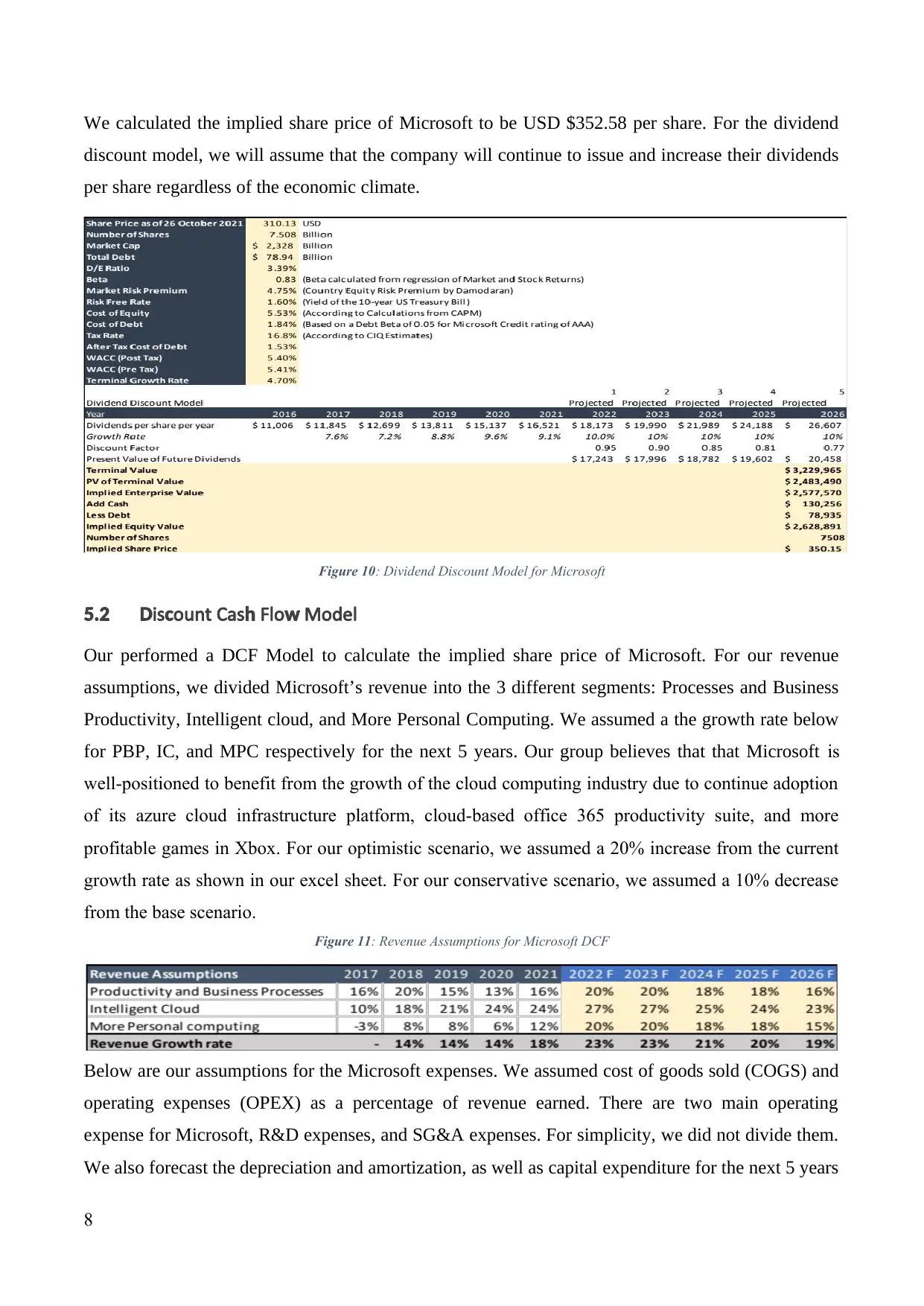
We calculated the implied share price of Microsoft to be USD $352.58 per share. For the dividend
discount model, we will assume that the company will continue to issue and increase their dividends
per share regardless of the economic climate.
Figure 10: Dividend Discount Model for Microsoft
5.2 is ount Cas Flo ModelD c h w
Our performed a DCF Model to calculate the implied share price of Microsoft. For our revenue
assumptions, we divided Microsoft’s revenue into the 3 different segments: Processes and Business
Productivity, Intelligent cloud, and More Personal Computing. We assumed a the growth rate below
for PBP, IC, and MPC respectively for the next 5 years. Our group believes that that Microsoft is
well-positioned to benefit from the growth of the cloud computing industry due to continue adoption
of its azure cloud infrastructure platform, cloud-based office 365 productivity suite, and more
profitable games in Xbox. For our optimistic scenario, we assumed a 20% increase from the current
growth rate as shown in our excel sheet. For our conservative scenario, we assumed a 10% decrease
from the base scenario.
Figure 11: Revenue Assumptions for Microsoft DCF
Below are our assumptions for the Microsoft expenses. We assumed cost of goods sold (COGS) and
operating expenses (OPEX) as a percentage of revenue earned. There are two main operating
expense for Microsoft, R&D expenses, and SG&A expenses. For simplicity, we did not divide them.
We also forecast the depreciation and amortization, as well as capital expenditure for the next 5 years
8
discount model, we will assume that the company will continue to issue and increase their dividends
per share regardless of the economic climate.
Figure 10: Dividend Discount Model for Microsoft
5.2 is ount Cas Flo ModelD c h w
Our performed a DCF Model to calculate the implied share price of Microsoft. For our revenue
assumptions, we divided Microsoft’s revenue into the 3 different segments: Processes and Business
Productivity, Intelligent cloud, and More Personal Computing. We assumed a the growth rate below
for PBP, IC, and MPC respectively for the next 5 years. Our group believes that that Microsoft is
well-positioned to benefit from the growth of the cloud computing industry due to continue adoption
of its azure cloud infrastructure platform, cloud-based office 365 productivity suite, and more
profitable games in Xbox. For our optimistic scenario, we assumed a 20% increase from the current
growth rate as shown in our excel sheet. For our conservative scenario, we assumed a 10% decrease
from the base scenario.
Figure 11: Revenue Assumptions for Microsoft DCF
Below are our assumptions for the Microsoft expenses. We assumed cost of goods sold (COGS) and
operating expenses (OPEX) as a percentage of revenue earned. There are two main operating
expense for Microsoft, R&D expenses, and SG&A expenses. For simplicity, we did not divide them.
We also forecast the depreciation and amortization, as well as capital expenditure for the next 5 years
8
Paraphrase This Document
Need a fresh take? Get an instant paraphrase of this document with our AI Paraphraser
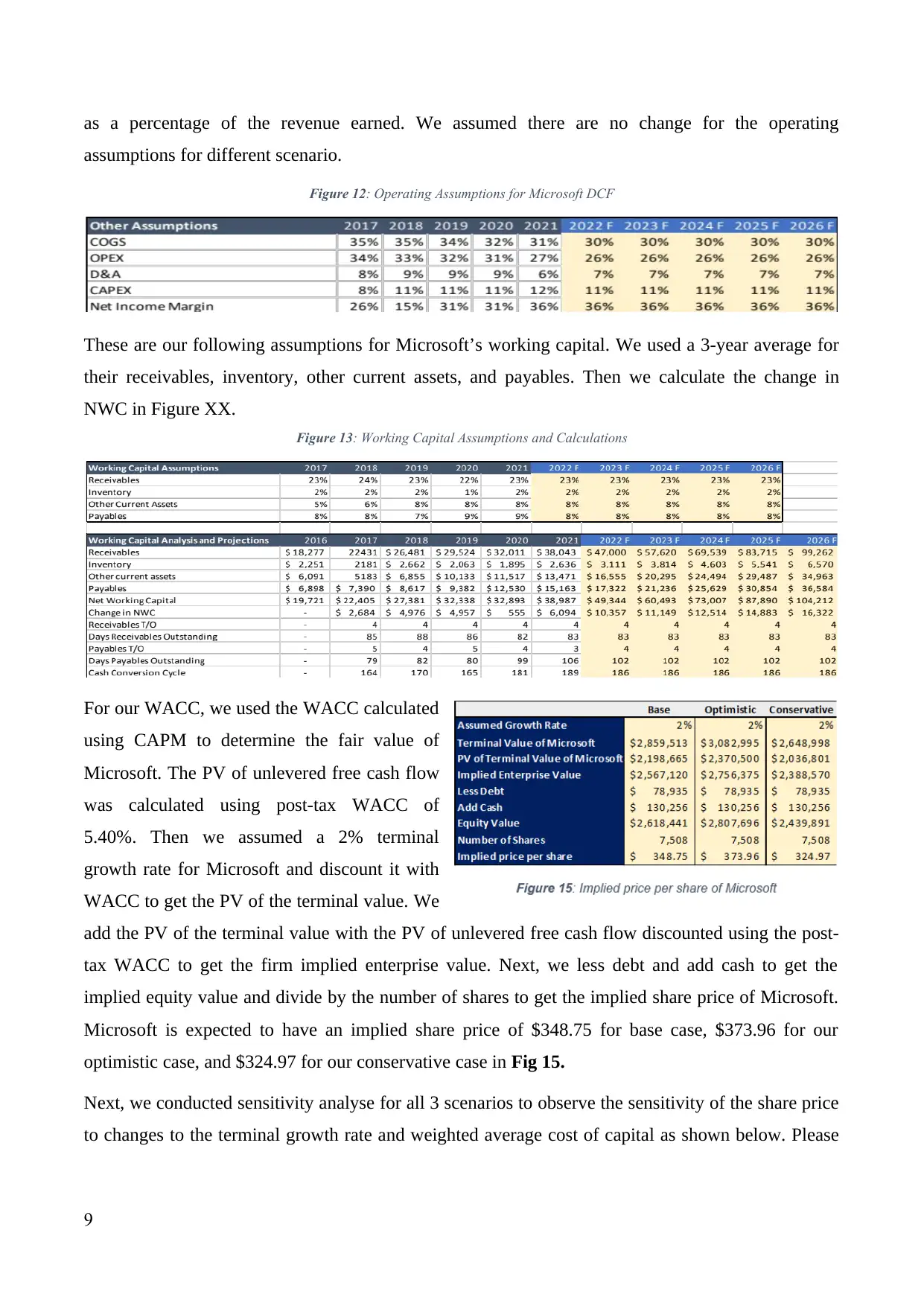
as a percentage of the revenue earned. We assumed there are no change for the operating
assumptions for different scenario.
Figure 12: Operating Assumptions for Microsoft DCF
These are our following assumptions for Microsoft’s working capital. We used a 3-year average for
their receivables, inventory, other current assets, and payables. Then we calculate the change in
NWC in Figure XX.
Figure 13: Working Capital Assumptions and Calculations
For our WACC, we used the WACC calculated
using CAPM to determine the fair value of
Microsoft. The PV of unlevered free cash flow
was calculated using post-tax WACC of
5.40%. Then we assumed a 2% terminal
growth rate for Microsoft and discount it with
WACC to get the PV of the terminal value. We
add the PV of the terminal value with the PV of unlevered free cash flow discounted using the post-
tax WACC to get the firm implied enterprise value. Next, we less debt and add cash to get the
implied equity value and divide by the number of shares to get the implied share price of Microsoft.
Microsoft is expected to have an implied share price of $348.75 for base case, $373.96 for our
optimistic case, and $324.97 for our conservative case in Fig 15.
Next, we conducted sensitivity analyse for all 3 scenarios to observe the sensitivity of the share price
to changes to the terminal growth rate and weighted average cost of capital as shown below. Please
9
assumptions for different scenario.
Figure 12: Operating Assumptions for Microsoft DCF
These are our following assumptions for Microsoft’s working capital. We used a 3-year average for
their receivables, inventory, other current assets, and payables. Then we calculate the change in
NWC in Figure XX.
Figure 13: Working Capital Assumptions and Calculations
For our WACC, we used the WACC calculated
using CAPM to determine the fair value of
Microsoft. The PV of unlevered free cash flow
was calculated using post-tax WACC of
5.40%. Then we assumed a 2% terminal
growth rate for Microsoft and discount it with
WACC to get the PV of the terminal value. We
add the PV of the terminal value with the PV of unlevered free cash flow discounted using the post-
tax WACC to get the firm implied enterprise value. Next, we less debt and add cash to get the
implied equity value and divide by the number of shares to get the implied share price of Microsoft.
Microsoft is expected to have an implied share price of $348.75 for base case, $373.96 for our
optimistic case, and $324.97 for our conservative case in Fig 15.
Next, we conducted sensitivity analyse for all 3 scenarios to observe the sensitivity of the share price
to changes to the terminal growth rate and weighted average cost of capital as shown below. Please
9
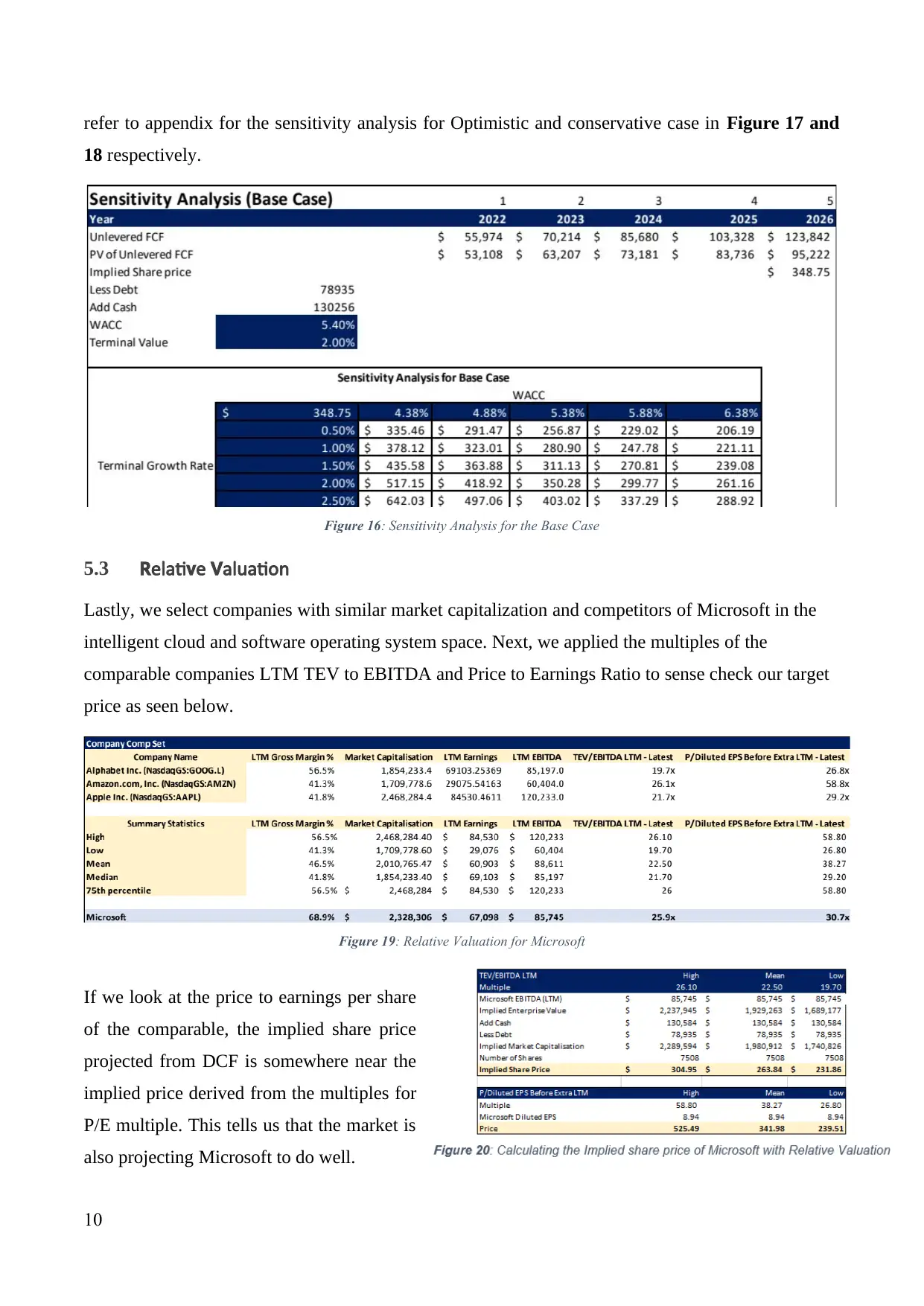
refer to appendix for the sensitivity analysis for Optimistic and conservative case in Figure 17 and
18 respectively.
Figure 16: Sensitivity Analysis for the Base Case
5.3 elati e aluationR v V
Lastly, we select companies with similar market capitalization and competitors of Microsoft in the
intelligent cloud and software operating system space. Next, we applied the multiples of the
comparable companies LTM TEV to EBITDA and Price to Earnings Ratio to sense check our target
price as seen below.
Figure 19: Relative Valuation for Microsoft
If we look at the price to earnings per share
of the comparable, the implied share price
projected from DCF is somewhere near the
implied price derived from the multiples for
P/E multiple. This tells us that the market is
also projecting Microsoft to do well.
10
18 respectively.
Figure 16: Sensitivity Analysis for the Base Case
5.3 elati e aluationR v V
Lastly, we select companies with similar market capitalization and competitors of Microsoft in the
intelligent cloud and software operating system space. Next, we applied the multiples of the
comparable companies LTM TEV to EBITDA and Price to Earnings Ratio to sense check our target
price as seen below.
Figure 19: Relative Valuation for Microsoft
If we look at the price to earnings per share
of the comparable, the implied share price
projected from DCF is somewhere near the
implied price derived from the multiples for
P/E multiple. This tells us that the market is
also projecting Microsoft to do well.
10
⊘ This is a preview!⊘
Do you want full access?
Subscribe today to unlock all pages.

Trusted by 1+ million students worldwide
1 out of 18
Related Documents
Your All-in-One AI-Powered Toolkit for Academic Success.
+13062052269
info@desklib.com
Available 24*7 on WhatsApp / Email
![[object Object]](/_next/static/media/star-bottom.7253800d.svg)
Unlock your academic potential
Copyright © 2020–2025 A2Z Services. All Rights Reserved. Developed and managed by ZUCOL.




